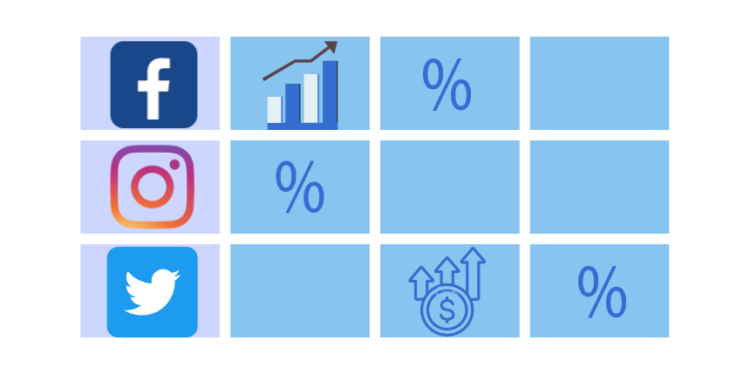- What is a social media audit?
- Benefits of auditing
- Prepare for the audit
- Conduct a social media audit (Facebook, Instagram, Twitter)
- What to do after auditing
- Setting SMART goals
- Conclusion
Whether you’re starting from scratch or already have an existing social media presence, it’s important to regularly conduct a social media audit. This is important to see your performance, identify areas for improvement, and align your social strategy with your business goals.
Social media has become an essential part of modern-day business.
However, simply having a social media presence is not enough for success.
Many companies tend to improvise without a social media strategy, which can result in missed opportunities and wasted resources.
In this guide, we’ll show you how to conduct a thorough social media audit.
What is social media audit and why is it important?
A social media audit is like a checkup for your social media accounts. This helps you see what’s working and what’s not working in your social media strategy.
It is a process of evaluating and analyzing a business’s social media presence and performance across various social media platforms. It involves reviewing and assessing the effectiveness of a company’s social media strategy, content, and metrics to identify areas for improvement and optimization.
It’s important because it allows you to identify areas of improvement, like which types of posts get the most engagement, what time of day is best to post, and which social media platforms are most effective for reaching your audience.
A business can identify strengths and weaknesses in its social media strategy, measure the effectiveness of its social media content, and determine the best ways to improve its presence. With this information, you can make better decisions about how to use social media to promote your business or brand.
Benefits of social media audits:
- Identify strengths and weaknesses of your presence
- Helps to understand the audience and their behavior
- Provides insights on which platforms to focus on
- Optimizes social media profiles and content
- Helps to set measurable goals and objectives for social media marketing
- Evaluates the effectiveness of past social media strategies
- Helps to identify opportunities for growth and improvement in social media marketing efforts
- Gives a clear understanding of the ROI(Return on Investment) of social media marketing.
Prepare for your social media audit
The word “auditing” might seem daunting at first. Some agencies even charge tens of thousands of dollars and spend months to complete a single audit.
However, your audit can be straightforward.
How frequently should you conduct an audit? Ideally, every quarter is best, but at least once a year is recommended. The important thing is to do it regularly and in a way that suits you.
It’s crucial to set clear goals and objectives for the audit, and performing one consistently can benefit your social media marketing strategy.
Some common goals and objectives include:
- Identifying areas of improvement in your social media strategy
- Measuring the effectiveness of your current social media efforts
- Understanding your audience and their behavior on social media
- Identifying opportunities to engage with your audience more effectively
- Analyzing your competitors’ social media activity and identifying areas where you can improve.
Social media audit template
A social media audit template is a pre-designed document or spreadsheet that helps individuals or businesses to analyze their presence and performance. It usually contains a series of questions, prompts, or categories to guide users in evaluating their social media accounts, including their profiles, content, engagement, and audience.
There are many providers of a social media audit template, ranging from free downloadable ones available online to paid services that offer more advanced analytics and reporting features.
Conduct a social media audit
Social media audit – steps overview
- Make a list of all your social media accounts across different platforms.
- Review your branding and ensure it is consistent across all channels.
- Identify which types of content perform best on each platform.
- Evaluate the performance of each channel in terms of metrics such as engagement, reach, and conversions.
- Analyze your audience on each platform, including demographics and behaviors.
- Based on your findings, set new goals and take action to optimize your social media strategy.
Gather all your social media platforms
To avoid as many added costs as possible, you can use Google Drive because it is a free option for a social media audit template. You must be familiar with it, but let me show you how to create a spreadsheet of every piece of information you will need.
Start at Google Drive and create new Google Sheets.
Since it is easy to share your work in Google Drive, in my opinion, it is a great tool to use.
Categorize the columns of the sheet, these can be your indicators of key performance.
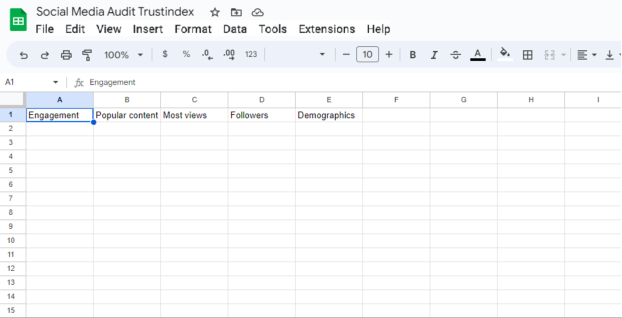
Examples for social media audit checklist:
- Engagement
- Popular content
- Most views
- Demographics
Next, enter some of the key information

I recommend adding date labels or monthly sections to your social media audits. This enables you to track changes over time when you conduct future audits.
To capture social media network-specific metrics, it may be helpful to include separate columns for each social media platform.
Now that you have a basic audit template in place, you’re ready to dive in and start analyzing your social media performance.
In this guide, we will focus on analyzing Facebook, Instagram, and Twitter, but if you use other or new social media platforms like TikTok or Pinterest, be sure to include those in your audit spreadsheet as well.
Let’s get started!
Facebook social media audit
Facebook offers plenty of data on your Pages, all conveniently accessible through the Facebook Business Suite.
The social media audit tools provide valuable insights into your ad accounts and business Page, helping you better understand your social media performance.
For the purposes of this guide, we will focus on general social media metrics. To begin, let’s take a quick look at the overview section of the Facebook Business Suite.
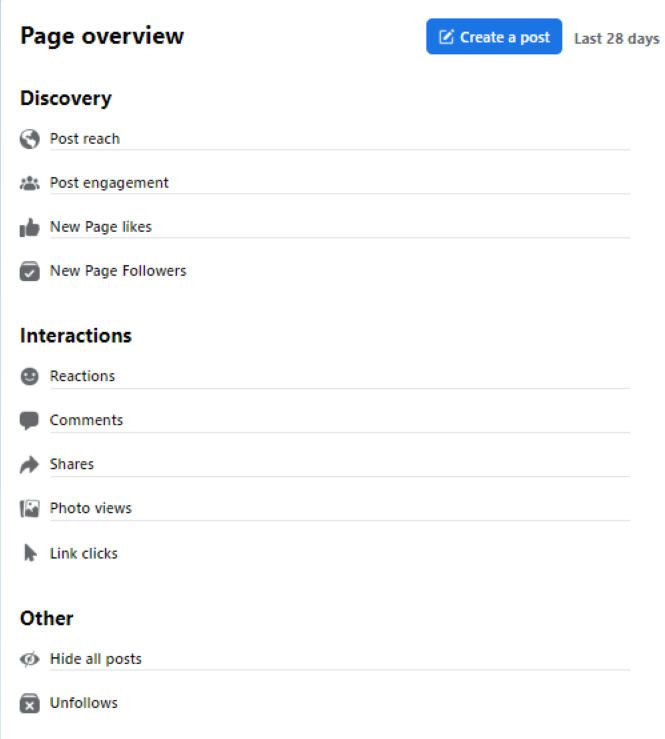
In the overview section of the Facebook Business Suite, you will immediately see key metrics such as Page likes, reach, and engagement.
These metrics can be filtered by time period, including today, yesterday, the last seven days, or the last 28 days.
To gain a deeper understanding of your social media performance, go to Content on the left, on the dashboard to access a breakdown of your top-performing posts.
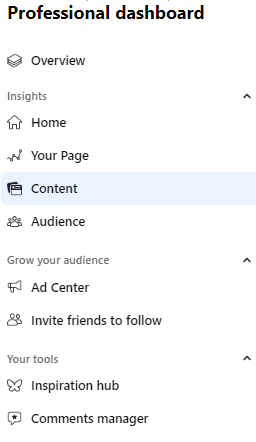
This information can help you identify which content resonates best with your audience and inform your future strategy.

Analyzing your top-performing posts on social media channels like Facebook can help you identify the type of content that resonates best with your audience and drives the most engagement and reach.
Once you have this information, you can go back to your social media audit spreadsheet and start filling it in accordingly.

In your audit spreadsheet, it’s important to track not only your key metrics such as followers and engagement but also the specific content that performed the best on your social accounts.
By doing so, you can determine what type of content resonates best with your audience and adjust your social media strategy accordingly.
What about demographics?
To gain insight into your audience demographics, you’ll need to visit the Audience tab on the social media platform.
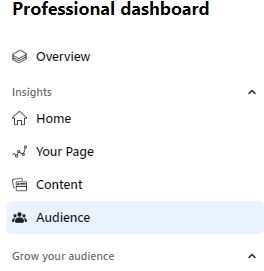
Here, you can access a report on all the Pages you manage, providing valuable information for the social media audit, on your audience demographics such as age, gender, location, and interests.
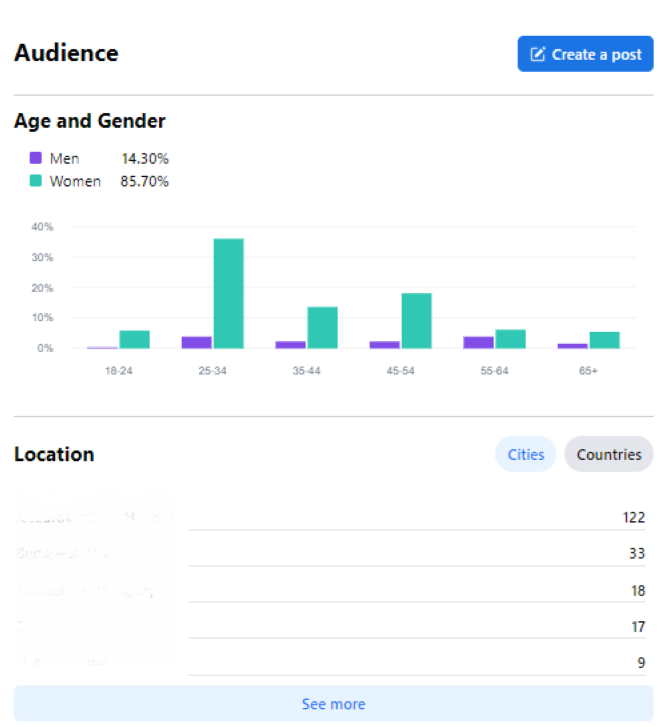
By understanding your audience demographics, you can better tailor your social accounts to meet their needs and preferences, ultimately driving higher engagement and better social media performance.
Additionally, you’ll be able to view valuable audience demographics information, including the ratio of men versus women that follow you, the percentage of users in each age group, the countries and cities your followers are from, and the other pages they like.
It’s important to take note of which gender, age groups, and locations make up the majority of your followers, as this information can help you tailor your content to better resonate with your audience. By using this data to create targeted content, you can drive higher engagement and improve your overall social media performance.
Be sure to input this information into your social media audit spreadsheet for future reference.

By completing a Facebook audit as described, you should now have a better understanding of your target audience and what type of content resonates with them the most.
As you continue to audit your Page in the future, you can compare these metrics to updated ones to gain insights into how your content is performing and make adjustments accordingly.
This will help you refine your strategy and ensure that you are consistently delivering engaging content that resonates with your target audience.
Instagram social media audit
To begin auditing your Instagram account, tap on the “hamburger” menu in the upper right-hand corner of your profile.
From there, select the Insights tab.

If you haven’t already, you’ll need to switch to a business account to access this feature.
Once you’ve made the switch and have at least 100 followers, you can start analyzing your account’s performance with all the data on Instagram Insights.
Keep in mind that this social media audit tool will only provide insights for content posted after you’ve upgraded to a business account.
Once you’ve clicked on the Audience tab, you’ll see a breakdown of your follower demographics, including their age range, gender, location, and active hours.
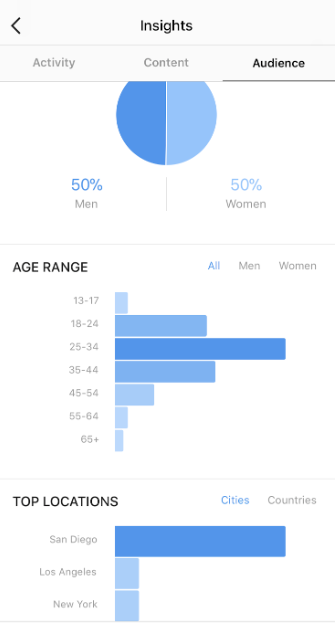
You can also see how your follower count has grown over time, as well as how often your followers are interacting with your content.
The other will show you the day of the week when your followers are most active. This is useful information to have when scheduling your posts.

Now that you have a better understanding of your Instagram audience, let’s fill in your spreadsheet.
Audit your Instagram posts
You can analyze their performance in two ways. First, click “View Insights” on an individual post to see the number of likes, comments, shares, saves, profile visits, and reach.
Check which hashtags attracted the most users and add them to your spreadsheet. Second, go to the “Content” tab on the Insights homepage to see all posts from the past year and their impressions.

You can use the data to determine what time of day or day of the week your audience is most engaged. This will help you schedule your posts for maximum visibility.
By regularly auditing your Instagram posts, you can fine-tune your content strategy and optimize your posts to better resonate with your target audience.
Twitter social media audit
See how many retweets, likes, and replies each tweet received, as well as the engagement rate by doing a social media audit on Twitter.
To get a better idea of what’s working and what’s not, filter the data by date range and export the information to a spreadsheet.
Use the information to identify patterns and insights, such as the topics or hashtags that generate the most engagement. You can use this information to refine your Twitter strategy and create content that resonates better with your audience.
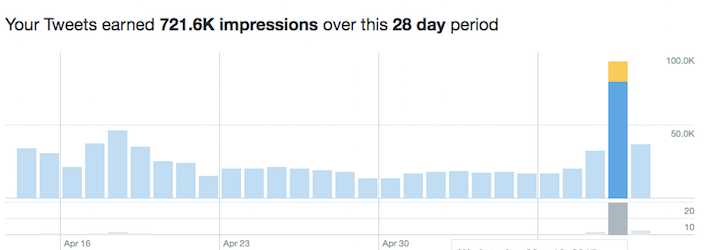
Twitter offers an easy-to-read social media analytics tool, for instance, a graph that shows your impressions (i.e. how many times your tweets were viewed) over the last 28 days. You can also choose to view your data for the last seven days or a custom time period.
To find your most popular tweets, click on the “Top Tweets” tab. This will show you which of your tweets received the most engagement and impressions during a specific period. Twitter calculates this based on likes, retweets, and replies.

When conducting social media audits on your Twitter account, it’s important to ask yourself if you notice any trends. Are certain calls-to-action or styles of tweets doing better than others?
To further complete the audit, you should also know who your followers are. To figure this out, visit “Audience insights” under the “Analytics” tab on top and make sure to change the selection to your followers.

On the first page, you can see information about your followers’ interests, consumer buying styles, household income categories, wireless carrier, and gender.
Clicking on the “Demographics” tab will give you even more information about your followers, from exact regions to home value.
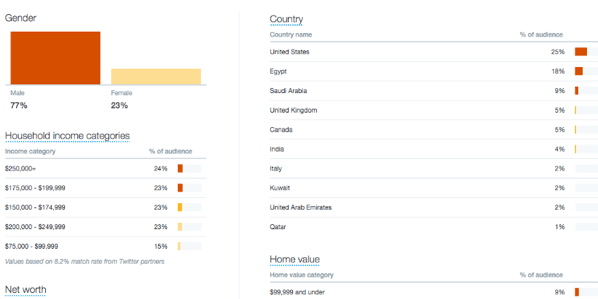
Selling products on Twitter
If you sell products online, the “Consumer Behavior” tab is a goldmine. Twitter shows you what kind of consumer buying style your followers fall under and what kind of consumer goods they enjoy purchasing.

Moving on to the “Lifestyle” tab, you’ll get a better idea of what interests your followers, which is great information to use for tailoring your content.
Finally, the “Mobile Footprint” tab tells you which carrier and devices your followers mostly use.
All of this information is conveniently available in the social media channels analytics system.
What’s next after a social media audit?
5 steps to take after auditing
1.) Review your content
Your social media audit should give you insights into what type of content resonates with your audience. Use this information to create more content that performs well and track the results.
- Identify the type of content your audience likes the most.
- Produce more of that content and measure the results.
- For example, if your Facebook fans prefer videos over images, produce more videos.
2.) Define your audience
With a better understanding of your audience demographics, you can tailor your content and marketing efforts to better serve them. Look for market reports and other publications that provide insights on your target audience, including trends and opportunities to take advantage of.
- Use the data you have collected in the social media audit to gain insights into the demographics of your fans.
- Look for trends and opportunities to take advantage of, such as new sales channels and promising promotional strategies.
3.) Focus on what works
Use the information from your social media audit to focus your marketing efforts on the platforms and content that perform the best for you.
Use the 80/20 rule, which involves doubling down on the social networks that work the best for you. For example, if social media channels like Instagram and Facebook drive the most traffic, focus your attention on those platforms. However, don’t be afraid to experiment with new platforms to see if they might perform well for your business.
- Determine which platforms are delivering the biggest results.
- Use the “80/20 rule” to double down on the social networks that work best for you.
4.) Set goals
Determine your social media goals, such as increasing your follower count, engagement, and website traffic. Make sure to track your progress through your social media audit and compare your results to previous audits.
- Set goals for your social accounts, such as follower count, engagement numbers, and website traffic.
5.) Evaluate your ad performance
If you use social media advertising, analyze the metrics for each ad type and creative to see which ones bring the best results. Invest more of your ad budget into those ads while scaling back on the ones that don’t perform as well. Consider running small experiments with paid campaigns to help calibrate your organic efforts.
- Test different social platforms to find out what works best
Set SMART goals for your social media strategy
SMART is an acronym that stands for Specific, Measurable, Achievable, Relevant, and Time-bound. This approach after a social media audit can help you stay focused, track progress, and ultimately achieve success in your social media strategy.
1.) Specific
Make sure your goals are specific and clearly defined. Rather than a broad goal like “increase engagement”, be specific about what you want to achieve. For example, “increase Instagram likes by 20% in the next 3 months”.
2.) Measurable
Your goals should be measurable so you can track progress and success. This means setting a specific metric or KPI to track, such as the number of followers, likes, comments, shares, or website traffic.
3.) Achievable
Have realistic and achievable expectations given your resources and capabilities. While it’s good to aim high, setting unrealistic goals can be demotivating and lead to disappointment.
4.) Relevant
Relevant goals to your overall business objectives and alignment with your brand values is important. For example, if your business is focused on sustainability, your social media goals should reflect that by promoting eco-friendly products or initiatives.
5.) Time-bound
Set a specific timeframe for achieving your goals. This will help you stay on track and measure progress. For example, “Increase Facebook reach by 10% in the next month” is a time-bound goal that provides a clear deadline for achieving results.
Conclusion
Performing a social media audit is an essential step for any business or individual looking to improve their social media presence. By taking a thorough look at all of your social media profiles, analyzing your content, evaluating your audience and engagement, and setting new goals, you can make informed decisions about how to optimize your strategy.
A successful social media audit can help you identify what’s working, what’s not, and what changes you need to make to ensure that you’re reaching your target audience effectively.
By regularly performing social media audits, you can stay up-to-date with the latest trends and ensure that your strategy is always evolving and improving.
